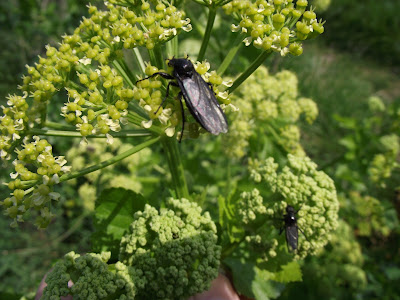Born in 1947, I lived my formative years through the 1950's, when life was still very much like a Famous Five novel. For our family in Sheerness then, Minster was still that big, wide world of meadows, hedgerows, orchards and cliffs - not the ruined landscape of housing developments that it is now. It was a world that us Sheerness kids, apart from being born in the hospital there, only got to see on special occasions. Late summer was one of those special occasions and on a warm and sunny weekend my mother would announce that tomorrow would be blackberry picking day! Joy oh joy, it meant the long walk from Sheerness along the coast to Minster, to that real and green world of the countryside, each of us carefully carrying our biscuit tin, lined with greaseproof paper, ready to be filled with blackberries. When you lived in a world of back streets and dusty alleys and the sun was something that you only glimpsed over the roofs of tall, terraced houses, this was a feast of such simple excitement that children today couldn't equate too or would be interested in.
It was two or three miles on foot just to get there and us children all ran here and there well in front, with so many new things to see and touch and smell, we were so excited. Our target was that area known as The Glen, which even today has been retained as a country park, an oasis in the middle of enormous rural development, but in those days was a wide open area surrounded by dense scrub. And to get to it we walked along tracks that are today Clovelly Drive and The Glen road but in those days were simply grassy paths through tall thickets of hawthorn and blackberry. They were full of butterflies and birds and bees that the young naturalist in me still had to discover and identify but I was young and easy and didn't care.

And then there was the blackberry picking and who could fill their tin up first - oh such joy as fingers and lips turned purple with the passage of countless berries. And as time passed we learnt that standing in stinging nettles leaves you with itching legs for hours after and that rubbing with dock leaves helps make it go away. We learnt that hawthorn bushes have nasty thorns, that daisies can be made into chains and holding buttercups to your face makes your chin turn gold. And when it couldn't possibly get any better we sat around mother and had our picnic, simple sandwiches and some lemonade, not like Ratty and Mole:-
"Rat appeared staggering under a fat, wicker luncheon basket...."what's inside it" asked the Mole, wriggling with curiosity. "There's cold chicken inside it", replied the Rat briefly; coldtonguecoldhamcoldbeefpickledgherkinssaladfrenchrollscressandwidgespottedmeatgingerbeerlemonadesodawater -" No it wasn't like that but we enjoyed what we had.
Sunshine, bees, birds, butterflies and of course blackberries, such a wonderful world to us then and still the long walk home to experience yet again. And on arriving home the tins were all stood in the cool of the scullery where pies would be made the next day. Us children were washed and fed, and tired out from all that sunshine and fresh air were packed off to bed, to dream of hedgerows and blackberry pies


















































